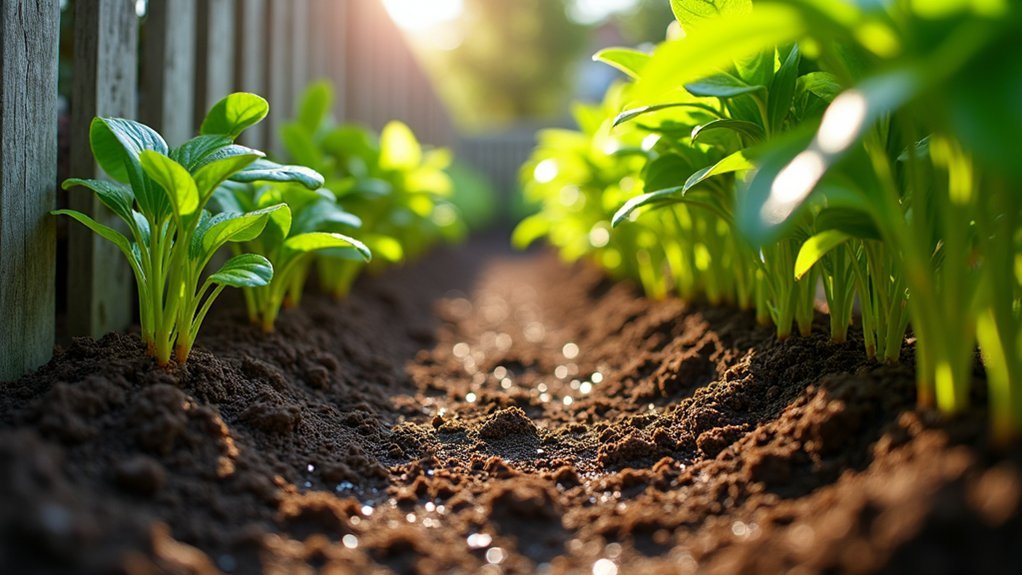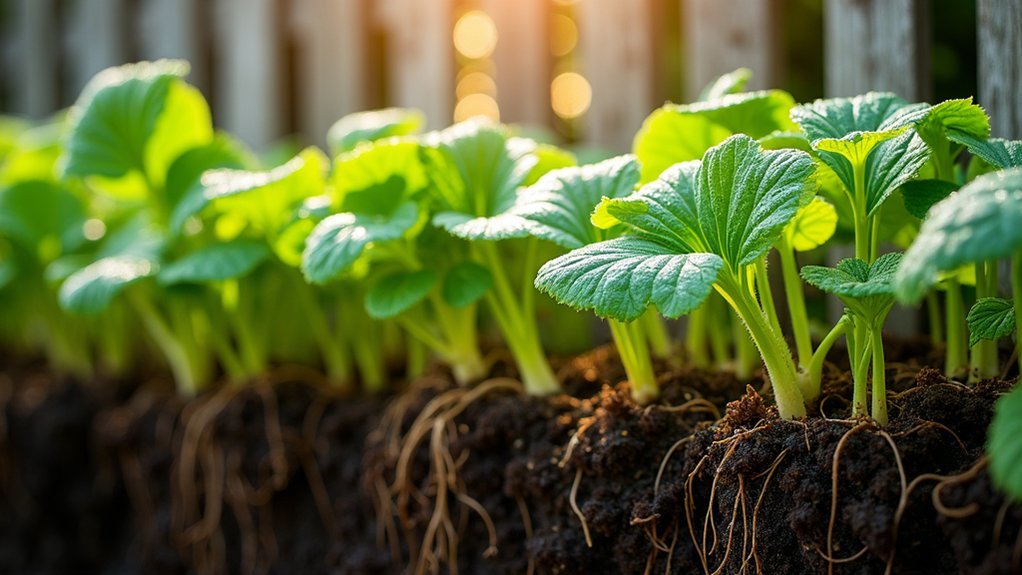For healthy fence plants, feed roots in early spring and fall while avoiding summer applications. Apply fertilizer beyond the plant’s base, extending 2-3 times past the drip line. Loosen soil before application and maintain 6-12 inches distance from stems to prevent root burn. Combine organic fertilizers for soil health with targeted chemical supplements when needed. Regular soil testing guarantees you’re addressing your plants’ specific nutrient requirements for peak growth.
Understanding Root Systems of Common Fence Plants

While many gardeners focus on the visible parts of fence plants, the hidden root systems ultimately determine their success.
Popular fence plants like boxwood and privet develop shallow root systems, primarily in the top 12-18 inches of soil where they absorb essential nutrients.
Fence favorites like boxwood and privet feed through shallow roots, drawing their strength from the topmost layers of soil.
What might surprise you is that these roots extend considerably beyond what you’d expect—typically 2-3 times past the plant’s drip line. This means you’ll need to apply fertilizer in a wider area than just at the base of the plant.
Before feeding your fence plants, get your soil tested to identify specific nutrient deficiencies and pH levels.
This is especially important for specialized plants like Rhododendrons that require particular soil conditions to thrive and properly absorb nutrients.
Seasonal Considerations for Root Feeding Applications
Although many gardeners assume plant feeding can happen anytime, timing your root feeding applications correctly makes all the difference for fence plants.
Early spring provides the ideal opportunity as plants emerge from dormancy, ready to absorb nutrients efficiently during their growth phase.
Don’t overlook fall as another prime time for root feeding. Your fence plants benefit from fertiliser applications during cooler autumn months, strengthening root systems before winter dormancy.
Avoid summer root feeding when heat stress compromises nutrient uptake and potentially harms your plants. Instead, use fall inspections to identify nutrient deficiencies that need addressing.
For best results, conduct soil tests before applying fertiliser. This guarantees you’re providing exactly what your fence plants need at the right time, promoting healthier growth and stronger boundaries.
Organic vs. Chemical Fertilizers for Fence Plant Health

Once you’ve determined the timing of your root feeding applications, selecting the right type of fertilizer becomes your next key decision.
Both organic fertilisers and chemical fertilisers offer unique benefits for your fence plants.
Organic options like compost and well-rotted manure improve soil structure and foster microbial activity, providing slow-release nutrients that enhance long-term plant health. They’re ideal if you’re focusing on sustainable soil development.
Chemical fertilisers, identified by their N:P:K ratios, deliver immediate nutrient availability when your plants need a quick boost. They’re excellent for correcting specific deficiencies but require careful application to avoid nutrient imbalances.
Consider conducting a soil test before choosing.
For enduring fence plant vigor, you might find a balanced approach works best—organic fertilisers for ongoing soil health with occasional chemical supplements for targeted nutrition.
Soil Preparation and Proper Application Techniques
Before your fence plants can effectively utilize any fertilizer, you’ll need to properly prepare the soil environment around them. Start by loosening and aerating the soil to improve nutrient absorption and facilitate root expansion. Conduct a soil test to determine pH and nutrient levels, enabling you to tailor your fertilization approach.
Proper soil preparation creates the foundation for effective fertilization and healthy fence plant development.
When applying fertilizers, use the correct method based on your plant’s stage—mix granular products into soil during planting or carefully apply around established plants.
For enhanced root feeding, consider digging narrow holes around plants and injecting slow-release liquid fertilizers directly into the root zone. Always maintain 6-12 inches distance from the plant base to prevent root burn while ensuring proper growth.
This careful application technique protects your plants while maximizing nutrient delivery where it’s needed most.
Monitoring and Adjusting Your Root Feeding Program

Successful fence plant maintenance depends on your ability to continually assess and modify your root feeding strategy. Regularly test soil for nutrient levels and pH to guarantee your approach addresses your specific fence plants’ needs.
Pay attention to growth indicators—leaf color, size, and overall vigor—as they’ll tell you when adjustments are necessary.
- Time your applications strategically, focusing on spring and early fall when plants actively grow
- Consider slow-release fertilizers for consistent nutrient delivery without risking harmful over-fertilization
- Watch weather patterns closely, as rainfall and temperature fluctuations affect how plants absorb nutrients
Environmental factors greatly impact your fence plants’ nutrient requirements. When you notice signs of stress or deficiency, don’t hesitate to modify your monitoring schedule and feeding program accordingly.
This responsive approach guarantees thriving, healthy fence plants year-round.
Frequently Asked Questions
What Is the Best Fertilizer for Rooting Plants?
For rooting plants, you’ll want a phosphorus-rich fertilizer (5-10-5) or balanced NPK (10-10-10). You can also use organic options like bone meal or products containing mycorrhizal fungi for enhanced root development.
What Is the Best Fertilizer for Hedge Plants?
You’ll want a balanced 10-10-10 fertilizer for your hedge plants. Slow-release options with mycorrhizal fungi work best, providing steady nutrients. For added benefits, consider organic compost or high-potassium fertilizers for flowering varieties.
How to Do a Deep Root Feeding?
To do deep root feeding, dig holes around the plant’s root zone, inject slow-release liquid fertilizer appropriate for your plant, then refill the holes. You’ll get best results by doing this in spring.
What’s the Best Fertilizer for Outdoor Plants?
You’ll get the best results with a balanced 10-10-10 NPK fertilizer. Use slow-release options for convenience or organic compost for soil health. Test your soil first to identify specific nutrient needs for your plants.
In Summary
You’ll see amazing results when you commit to a consistent root feeding regimen for your fence plants. Remember to tailor your approach based on your specific plants, adjust with the seasons, and balance between organic and chemical options. By preparing soil properly and monitoring plant responses, you’re ensuring your fence line stays healthy and vibrant year after year. It’s worth the effort!





Leave a Reply